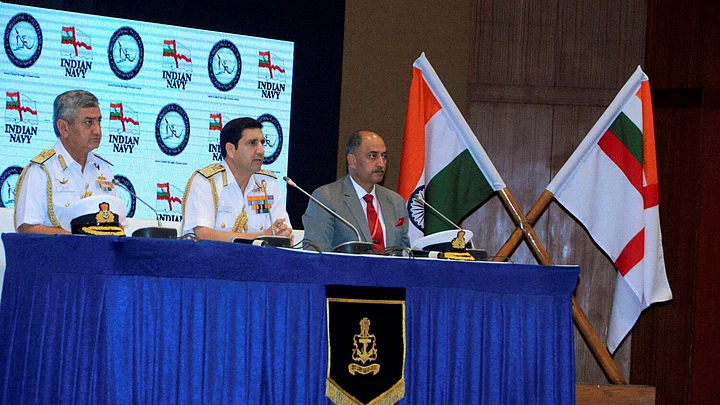India’s Maritime Equations
- India is the most credible regional naval power in the Indian Ocean Region and China is seeking to establish the same in the western Pacific.
- The US has a visible naval presence in the Indo-Pacific and the re-arrangement of naval assets to manage China’s emergence is the current naval dynamic in the region.
- The focus is on cooperative effort at sea, but security and strategic underpinning of the maritime domain merit scrutiny.
- The presence of the major powers, a contour of 50 plus countries and naval chiefs of 20 others, has complex policy relevance for India.
- The US, China and India will have to work towards an acceptable index of strategic equipoise in the maritime domain that will not disrupt their geo-economic trajectory.
The high-point of the International Fleet Review (IFR) in Visakhapatnam is President Pranab Mukherjee reviewing the 90 plus warships on Saturday from the Presidential yacht and the assembled ships will include 22 from foreign navies. This IFR is the second such mega maritime event – the first having been held in Mumbai in 2001.
IFR 2016 has an impressive contour with 50 plus countries’ participation and over 20 are represented by their naval chiefs – and this includes the US. Other major navies that are part of the IFR are Russia, France, Japan, China and the regional representation includes Bangladesh and Sri Lanka – but no Pakistan. Unity through the oceans is the theme for the IFR and this builds on the ‘friendship’ theme of 2001.
PM Modi and members of the Union cabinet will also witness the review and operational demonstrations that will showcase the capabilities of the Indian Navy (IN) – the silent service – which is also the smallest of the three Indian armed forces. The strategic relevance and profile of the IN is inversely proportional to its size and budgetary allocation - 16 percent of the total defence budget. This pattern is unlikely to change significantly in the near future given the insular and inflexible nature of budgetary planning in India.
To IN’s credit, the service has been able to outline a holistic strategic vision for itself in relation to the larger national effort. This document, which was first published a decade ago by the naval HQ, has been periodically updated, and the latest iteration is now in the public domain.
Over the last two years, the IN has gone through a bad patch and this includes the loss of a submarine in the harbour which resulted in the resignation of the naval chief at the time, and a steady decline in the quantity and material quality of major platforms.
To the credit of Naval Chief Admiral Robin Dhowan, the IN is now back on an even keel and the scale of the IFR is testimony to the institutional confidence and credibility that has since been restored.
While the focus is on the cooperative effort at sea, it is the latent security and strategic underpinning of the maritime domain that merits scrutiny. Cooperative effort at sea is a shared objective in relation to maintaining safety and security of the sea lines of communication in the extended Indian Ocean region (IOR), and Humanitarian Assistance and Disaster Relief (HADR) is a motherhood and apple-pie commitment
The global maritime focus has progressively shifted to the western Pacific ocean and the IOR (from the oil rich Persian Gulf to the Malacca strait) and this is often referred to as the Indo-Pacific theatre.
This is the critical trade or energy conduit of the early 21st century that sustains economic vitality and an instructive foot-print is discernible. Concurrently, it is estimated that over the next two decades, if not earlier, the global economy will have a tri-polar characteristic – as regards single state economies comprising China, the US and India. But this will be an ‘uneasy’ strategic triangle.
India is the most credible regional naval power in the IOR and China is seeking to establish the same profile in the western Pacific. This however is contested by neighbors, including Japan and some of the ASEAN nations such as Vietnam.
The US has a visible naval presence in the Indo-Pacific and the re-arrangement of naval assets, (aka the Obama pivot) to better manage the emergence of China as an assertive naval power, is the current naval dynamic in the region.
How will the prevailing US led status quo in the maritime domain play out in the near future? This is often reiterated as ‘respect for international law’ – most recently reiterated by Delhi during the visit of Vice President Hamid Ansari to ASEAN.
Will a China-Russia strategic closeness (but not quite an alliance) acquire a maritime or naval texture? And will this influence the current imbroglio in the South China Sea?
This unstated sub-text at the IFR, and for India, the presence of the major powers, has complex policy relevance. The growth of the IN to the profile it has currently acquired, such as underwater nuclear propulsion has been enabled to a large extent by Moscow. Against this backdrop, what kind of a naval partnership can Delhi envisage with the US that will be politically and fiscally affordable and equitable?
For Washington, the abiding post Cold War conundrum is, what kind of an Indian Navy will be in the long term interest of the US? By extension, the US, China and India will have to work towards an acceptable index of strategic equipoise in the maritime domain that will not disrupt their geo-economic trajectory.
South Block will have to acquire the institutional competence to read these tea-leaves astutely, even as the bandwidth of maritime challenges that the IN will have to face will perforce encompass Mumbai 2008 to the evolving compulsion of nuclear deterrence at sea.
(The writer is a leading expert on strategic affairs. He is currently Director, Society for Policy Studies.)
